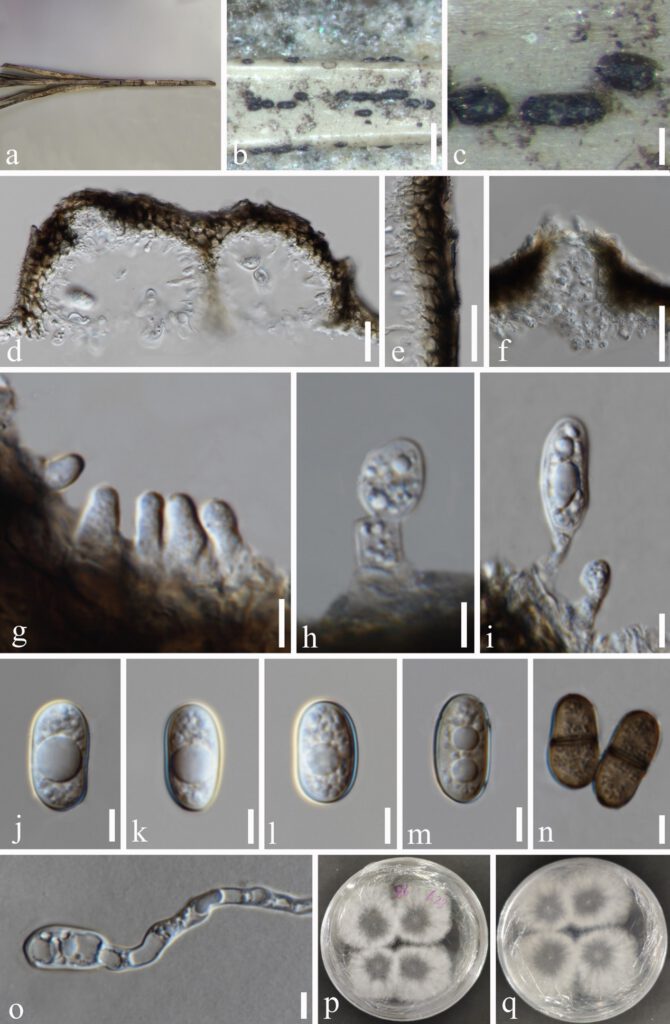Neodeightonia septata N. Wu, A.J. Dissanayake & Jian K. Liu sp. nov. (FIGURE 2)
MycoBank number: MB ; Index Fungorum number: IF; Facesoffungi number: FoF 10671;
Etymology: The specific name “septata” refers to the septum observed in mature conidia
Holotype: MFLU 21–XXXX
Saprobic on a dead culm of palm, as raised black spots on the host surface. Sexual morph: not observed. Asexual morph: Conidiomata 80–134 μm diam., 53–105 μm high (n = 20), superficial or semi-immersed in the substrate, uni-locular to multilocular, individual or aggregated, cylindrical or subglobose, dark brown to black. Peridium up to 10–21 μm wide, composed of dark brown thick-walled textura angularis, becoming thin-walled and hyaline towards the inner region. Ostiole 25–30 μm diam., cylindrical, straight or curved, centrally or laterally located. Paraphyses absent. Conidiophores reduced to conidiogenous cells. Conidiogenous cells 4–8 μm long, 3–5 μm wide (n = 20), hyaline, cylindrical, straight to curved, smooth-walled. Conidia (13.5–)15–19(–21) × (6–)8–9(–12) μm (av. = 17 × 9 μm, n = 50), ellipsoid to obovoid, rounded at the apex, frequently constricted in the middle, initially hyaline, aseptate, guttulate, without mucilaginous sheath, becoming pale to dark brown when mature, granulate, forming one septate.
Culture characteristics: Conidia germinating on PDA within 12 h. Colonies reaching 90 mm diam. after 4–5 days at 20–23 °C, circular, white during the first few days, sparse, aerial, surface smooth with crenate edge, filamentous, after 2 weeks becoming dark brown to black.
Material examined: THAILAND. Chiang Rai: Thoeng, Tambon Nang Lae, Rai Ruen Rom Organic Farm, 19°39’30.2”N, 100°09’26.4”E, on a dead palm culm, 11 June 2019, Na Wu, YW86 (MFLU 21–XXXX, holotype), ex-type living culture MFLUCC 21–XXXX; ibid., GZAAS 21–XXXX, isotype, living cultures GZCC 21–XXXX, GZCC 21–XXXX.
Known distribution: Chiang Rai, Thailand.
Notes: In the phylogenetic tree generated from maximum likelihood analysis based on combined ITS, LSU, SSU and tef sequence data (FIGURE 1), Neodeightonia septata (MFLUCC XXXX, GZCC XXXX, GZCC XXXX) clustered closer to N. rattanica (MFLUCC 15–0712, MFLUCC 15–0313) and N. rattanicola (MFLUCC 15–0319) with 100% ML bootstrap support, 99% MP bootstrap support and 100% Bayesian posterior probabilities. However, N. septata is morphologically clearly distinguished from above mentioned species by having 1-septate conidia, while no septum was observed in N. rattanica neither in N. rattanicola (Table 2).

FIGURE 1. Phylogenetic tree generated from maximum likelihood (ML) analysis based on combined ITS, LSU, SSU and tef sequence data for selected closely related genera within the family Botryosphaeriaceae. Bootstrap values for maximum likelihood (ML) and maximum parsimony (MP) equal to or greater than 75% are placed above and below the branches, respectively. Bayesian posterior probabilities (BYPP) equal or greater than 0.95 are denoted in thickened branches. The strain numbers are mentioned after the species names. Ex-type strains are indicated in bold. The isolates of newly introduced species are in red and new collection of the previously known species is in blue. The tree is rooted with two isolates of Barriopsis iraniana (IRAN 1448C, IRAN 1451C).

FIGURE 2. Neodeightonia septata (MFLU 21–XXX Holotype): a. Material examined. b, c. Appearance of black conidiomata on palm culm. d. Vertical section of conidioma. e. Section of peridium. f. Ostiolar region. g–i. Conidiogenous cells and developing conidia. j–m. Hyaline, aseptate immature conidia. n. Brown, 1-septate mature conidia. o. Germinating conidium. p, q. Colonies after 7 days on PDA (p from above, q from below). Scale bars: b = 50 μm, c = 10 μm, d–f = 20 μm, g–o = 5 μm.
